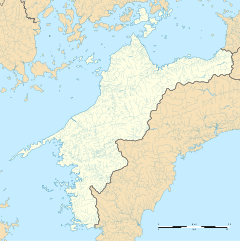Nyūgawa Station (Ehime)
Y36 Nyūgawa Station 壬生川駅 | |
|---|---|
 Nyūgawa Station in 2017 | |
| General information | |
| Location | Japan |
| Coordinates | 33°55′46″N 133°05′08″E / 33.9295°N 133.0856°E |
| Operated by | |
| Line(s) | ■ Yosan Line |
| Distance | 126.8 km from Takamatsu |
| Platforms | 1 side + 1 island platforms |
| Tracks | 3 + 1 passing loop + other sidings |
| Construction | |
| Structure type | At grade |
| Parking | Available |
| Accessible | No - platforms linked by footbridge |
| Other information | |
| Status | Staffed - JR ticket window (Midori no Madoguchi) |
| Station code | Y36 |
| Website | Official website |
| History | |
| Opened | 1 May 1923 |
| Passengers | |
| FY2019 | 801 |
| Location | |
Nyūgawa Station (壬生川駅, Nyūgawa-eki) is a passenger railway station located in the city of Saijō, Ehime Prefecture, Japan. It is operated by JR Shikoku and has the station number "Y36".[1][2]
Lines[edit]
Nyūgawa Station is served by the JR Shikoku Yosan Line and is located 126.8 km from the beginning of the line at Takamatsu.[3] Yosan Line local trains which stop at the station only serve the sector between Iyo-Saijō and Matsuyama. Connections with other local or limited express trains are needed to travel further east or west along the line.[4]
In addition, the following JR Shikoku limited express services also serve the station:[4]
- Shiokaze - from Okayama to Matsuyama and Uwajima
- Ishizuchi - from Matsuyama to Takamatsu and Uwajima
- Midnight Express Matsuyama - in one direction only, from Matsuyama to Niihama
- Morning Express Matsuyama - in one direction only, from Niihama to Matsuyama
Layout[edit]
The station consists of an island platform and a side platform serving three tracks. The station building houses a waiting room, a convenience store and a bakery, and a JR ticket window (with a Midori no Madoguchi facility). The island platform is accessed by means of a footbridge. Car parking is available.[2][5][6][7]
A passing loop runs to the west of the island platform and several short sidings branch off the main tracks.[3]
Adjacent stations[edit]
| « | Service | » | ||
|---|---|---|---|---|
| JR Limited Express Services | ||||
| Iyo-Saijō | Shiokaze | Imabari | ||
| Iyo-Saijō | Ishizuchi | Imabari | ||
| Imabari | Midnight Express Matsuyama | Iyo-Saijō | ||
| Iyo-Saijō | Morning Express Matsuyama | Imabari | ||
| Yosan Line | ||||
| Tamanoe | Local | Iyo-Miyoshi | ||
History[edit]
Nyūgawa Station opened on 1 May 1923 as the terminus of the then Sanuki Line which had been extended westwards from Iyo-Saijō. It became a through-station on 1 October 1923 when the line was further extended to Iyo-Miyoshi. At that time the station was operated by Japanese Government Railways, later becoming Japanese National Railways (JNR). With the privatization of JNR on 1 April 1987, control of the station passed to JR Shikoku.[8][9]
Surrounding area[edit]
- Saijo City Food Creation Center
- Pompoko Bridge
- Saijo City Hall Toyo General Branch (former Toyo City Hall)
See also[edit]
References[edit]
- ^ "Shikoku Railway Route Map" (PDF). JR Shikoku. Retrieved 27 December 2017.
- ^ a b "壬生川" [Nyūgawa]. hacchi-no-he.net. Retrieved 1 January 2018.
- ^ a b Kawashima, Ryōzō (2013). 図説: 日本の鉄道 四国・九州ライン 全線・全駅・全配線・第2巻 四国西部エリア [Japan Railways Illustrated. Shikoku and Kyushu. All lines, all stations, all track layouts. Volume 2 Western Shikoku] (in Japanese). Kodansha. pp. 13, 67. ISBN 9784062951616.
- ^ a b "Nyūgawa Station Timetable" (PDF). JR Shikoku. Retrieved 31 December 2017.
- ^ "壬生川駅" [Nyūgawa Station]. shikoku.org.uk. Retrieved 1 January 2018.
- ^ "壬生川駅" [Nyūgawa]. sanyukai.sakura.ne.jp. Retrieved 1 January 2018.
- ^ "壬生川駅" [Nyūgawa]. JR Shikoku Official Station Website. Retrieved 1 January 2018.
- ^ Ishino, Tetsu; et al., eds. (1998). 停車場変遷大事典 国鉄・JR編 [Station Transition Directory – JNR/JR] (in Japanese). Vol. II. Tokyo: JTB Corporation. p. 635. ISBN 4-533-02980-9.
- ^ Ishino, Tetsu; et al., eds. (1998). 停車場変遷大事典 国鉄・JR編 [Station Transition Directory – JNR/JR] (in Japanese). Vol. I. Tokyo: JTB Corporation. pp. 213–215. ISBN 4-533-02980-9.
External links[edit]
![]() Media related to Nyūgawa Station (Ehime) at Wikimedia Commons
Media related to Nyūgawa Station (Ehime) at Wikimedia Commons
- Nyūgawa Station (JR Shikoku)(in Japanese)


